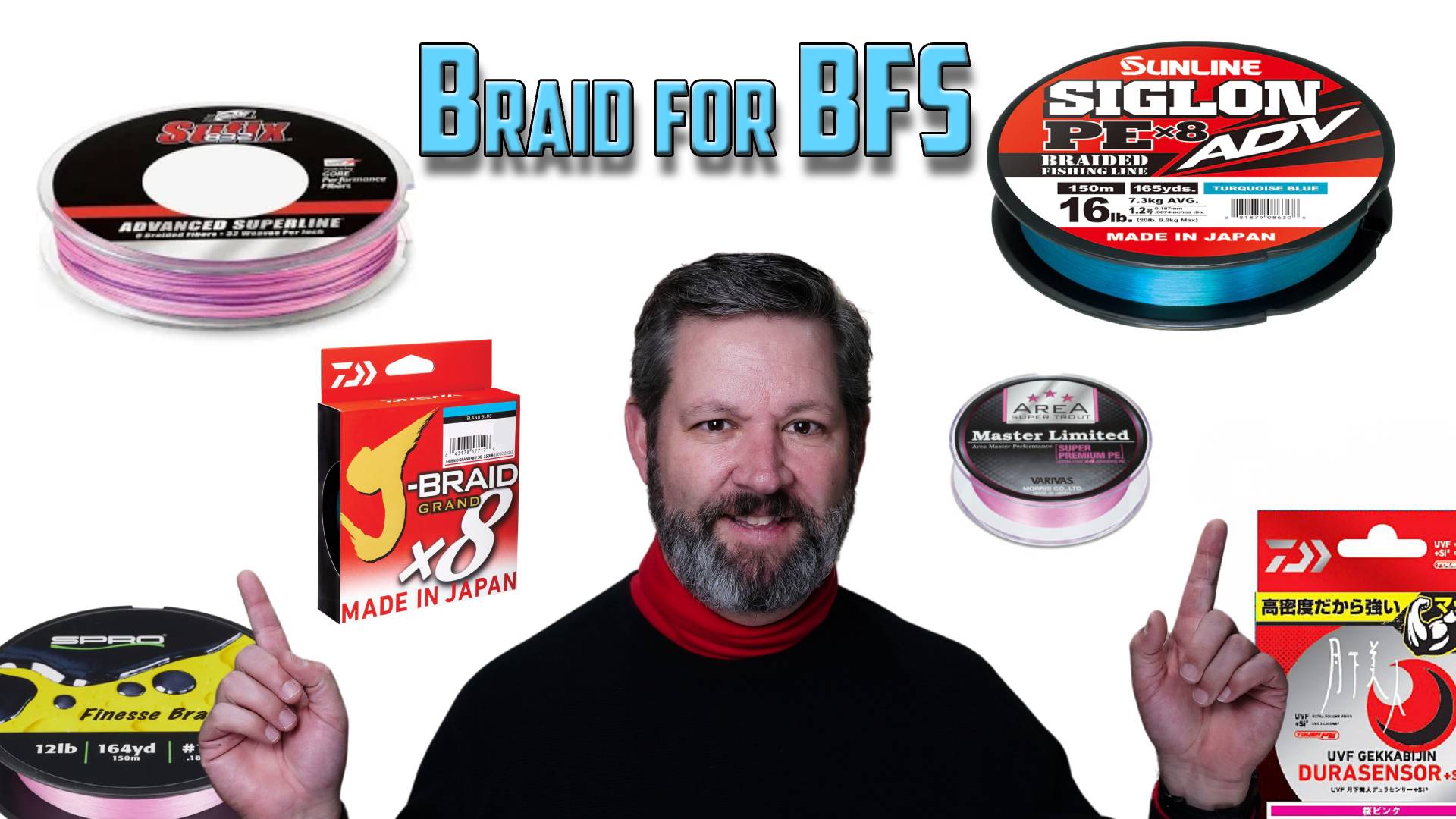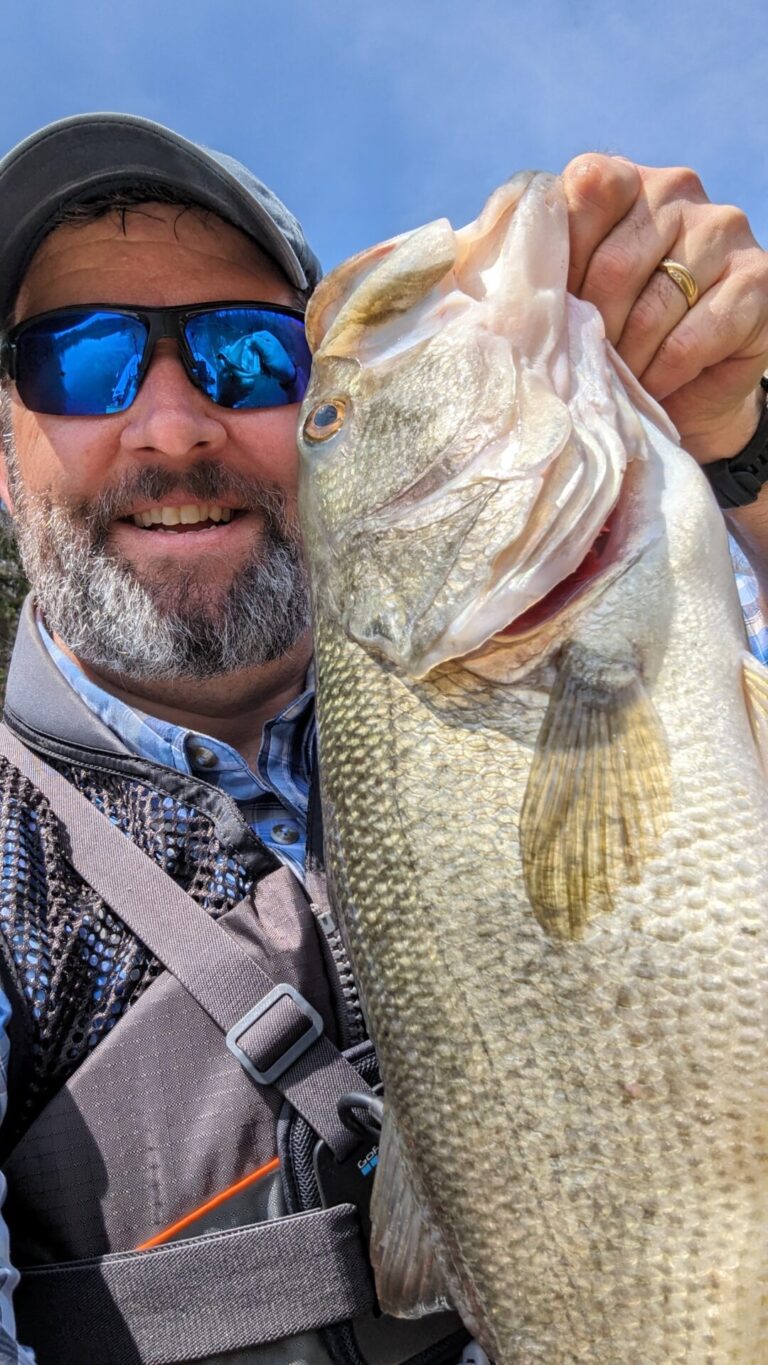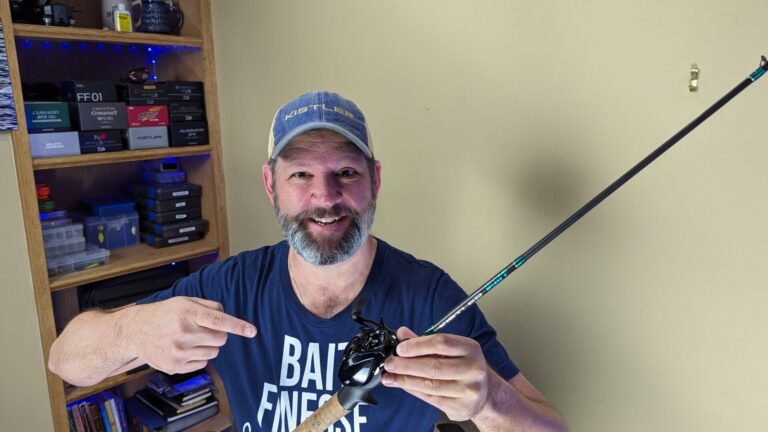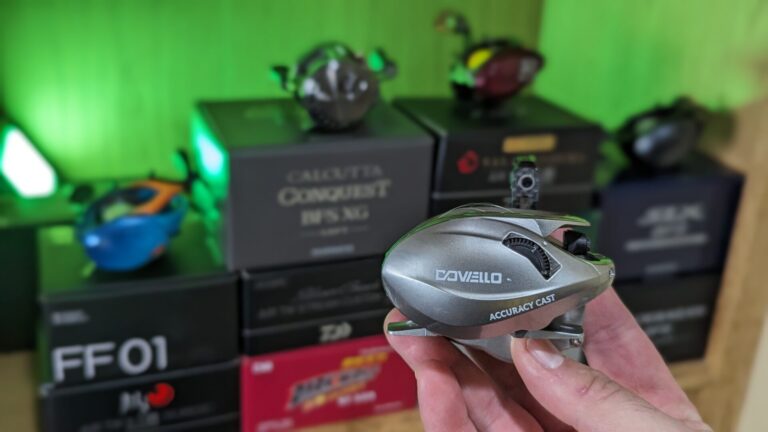Braided Line: Why it’s Best for BFS Fishing and 5 Solid Choices
When I started my Bait Finesse Style (BFS) fishing journey, I started with braided line. Braided line is just so thin and light for its rated strength it makes casting effortless – which usually works out well with BFS. Here’s why I believe braid is best for BFS.
Table of Contents
Braid Line vs. Fluorocarbon for BFS
I have put both mono and fluorocarbon lines on BFS reels and I tend to lose distance and “ease of casting”. The brakes need to be set higher usually, so the spool doesn’t run as free. Plus my worst backlashes were with non-braided lines.
Braided fishing line also gives you the option of having high-visibility colors – which is amazing for sight fishing. I go into this and a deeper comparison in my article about pink braided line.
What about Monofilament Line?
Mono is an option. It has most of the drawbacks of Fluro and none of the benefits. Well, OK – it has at least two benefits:
- It’s less expensive
- It’s neutrally buoyant
Mono is the line you probably grew up fishing if you were born before 1980. It is less expensive than the other options. And being “neutrally buoyant” works well for topwater or jigs, and anything in between.
But, it has a lot more stretch and lacks sensitivity. There’s also an “urban legend” that mono will crush your spool. That’s highly unlikely, and I’ve seen the same thing said about braid. But. I have seen it happen on really light weight spools.
Bottom line on mono: I find BFS to be a high-performance style of fishing, so I use a high-performance line. And that means braided line.
Name Brand Braided Line vs AliExpress
Best Brands
I’ve tried a fair amount of brands, and so far my favorites are Varivas, Daiwa DuraSensor, and then Daiwa J-braid. I’ve been using J-braid for all of last year with a few exceptions (I also had some remaining Varivas on a few reels). Preparing to switch to Sunline Siglon ADV for a while, then will probably try Suffix 832 starting in late summer or fall.
Those last two seem to be rated the best by lab tests for my typical use. And Suffix is available in more colors: everything from Hi-Vis Yellow to blue braided line. I’m impressed with the options Suffix has for finesse braid
AliExpress Braid
I tried some of the budget Ali lines for a while and was never truly impressed long-term – especially when compared to the better-known and tested lines. It’s kind of like most of the AliExpress rods and reels – they’re good for their price, but don’t usually hold up in comparison to the JDM or US market offerings.
In lab testing, the Aliexpress J-braid was significantly inferior to JDM and US samples. the only line I could recommend currently as a budget line is Kingdom MicroFly.
Their main advantage is they offer really thin lines, but the lines hold up decent. Their abrasion resistance is poor, so a leader is a must if you choose to use them.
Is it Worth Spending More for Better Line?
The thing with fishing line is, you really can’t modify it or compensate for it much. In the big picture, line is not the biggest expense in fishing (even if you’re spooling up 15-20 reels per year like me).
But it is the main thing that connects you directly to the fish. Hooks and line. I try not to cheap out on those these days. I’ve had two line breaks while fighting a fish since giving up on cheap line. One was a GIANT snook that would have been the biggest fish of my life. But I was fishing for Giant bluegill and exotics on a rod rated from 1-6 grams. The line broke at the rub spot on the rod it was bent over so far fighting that fish.
The other was a big smallie while bank fishing. After a couple of large jumps, it made a run to the bank and a little in-cut. The line wrapped around some large rocks and sheared off.
That’s primarily why you run the Fluoro leader – abrasion resistance. In this case the rock was 15 feet up the line or so. If you run a leader that’s same rating or lighter than your braid, it should break off at the hook when snagged. Saving you time and money while fishing too.
But only if your braid has good knot strength…
Those two memorable, spectacular fish are my only line breaks in 140 or so outings since switching to quality braid and leader. I’ve landed many more fish I felt I should have lost.
My Top 5 Braided Lines for BFS
Varivas
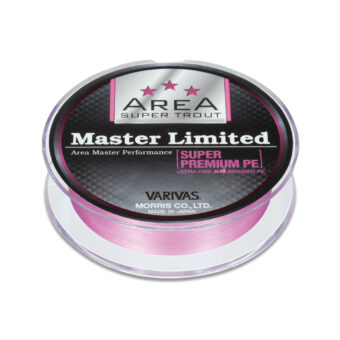
So far, everything from Varivas has been quality. But it typically comes at a price. And since I usually use 50 yards per reel, their 75-meter spools are even more expensive, because I only get one reel filled.
My favorites are the Area Super Trout Master Limited and the Bait Finesse X4.
Daiwa DuraSensor

I originally bought this with my Daiwa Gekkabijin reel. I bought it because it was matched to the reel, and because they had a pink option. It has been one of the best lines I’ve used.
I get mine from Digitaka.
Sunline Siglon ADV

As I started looking for something better than what I had been using the previous year, I really dug a little deeper into lab testing rather than what was available and popular opinion. Through my digging, Sunline Siglon PE 8 ADV came out on top.
It’s got great knot strength, really good abrasion resistance for braid, and is super thin and consistent. This helps create not only longer casts, but longer, repeatable casts.
The downside is a more limited color palette, But both the multi-color and the blue are colors I’ve used before. The blue will be on most of my reels for the start of 2024.
As of the time of this writing, Sunline has this on sale, so not sure what the future is for this line. But it’s an amazing line, and hopefully, there’s a new version coming. Or it’s simply on sale. It’s also available on Amazon.
Daiwa J-Braid Grand

I’ve been using J-braid and J-braid Grand almost exclusively in 2023. It’s a solid line. The biggest bonus for me was the cost was less than Varivas, and it was readily available on Amazon. Since I always have new reels coming in, I could get a fresh spool of braid in 2 days when I needed it.
I didn’t have any failures with the J-braid. I could still cast down to 1 gram pretty easily on the right set-ups. It was the line I used when I caught my first peacock bass – so maybe it will always have a special place in my heart. (yeah, probably not).
As I dug a little deeper on lab tests, I was pretty surprised how the J-braid performed. It wasn’t all that good. For now I still think it’s the best performance value you can readily get. That may change when I do an extended test with the Suffix 832.
Suffix 832

For finesse braid, the Suffix 832 and the Sunline Siglon are about the top 2 lines in lab testing. I have probably discounted it a bit as a top line because it was the same braid I could buy locally for my spinning reels. Although the 6lb and 8lb test are harder to find in local stores.
But that’s what may make this the best bFS braid for me eventually: its availability. Suffix 832 is usually available in chain tackle stores, you can get it on Amazon. And it’s pretty budget-friendly as far as top braided lines are concerned.
I chose the Sunline for now because the FG knot strength is significantly better on the Sunline, and the breaking strength is closer to the rated number.
But both lines are far superior to the Daiwa I’ve been using in tests, and are top braided lines in each test category. Hopefully, they fish better as well.
As an additional bonus, it is available in a lot of colors. Pretty much every color I’ve used except orange.
Best Knot for Braid to Leader
While braided lines are in general super strong for their diameter and they cast more easily, one downside of braided lines is their abrasion resistance. If you’re fishing in rocky areas or doing a lot of bottom contact fishing, you definitely want a leader.
I like to use a fluorocarbon leader for the near invisibility benefits and because it has some stretch, but not as much stretch as Monofilament. So what not is best for typing your leader to your mainline braid?
FG Knot
Tied properly, the FG knot’s breaking strength can exceed the mainline strength. It is also about the thinnest diameter knot, making easily pass through the micro-guide on BFS rods.
When you use a leader that has a lower breaking strength than the mainline braid, you will also normally lose snagged lures very close to the hook. This saves you on line costs, but it can also save you from tying on a new leader while on the water.
Plus it’s good to leave as little line as possible in the water, right?
The downside of the FG knot is it can be tricky to tie – especially on the water. The super thin lines and the lighter-weight rods make it ever more challenging to tie using the conventional methods. But I have an “easy button” for FG knots!
Easiest Way to Tie an FG Knot
When I first started typing FG knots, I had the braided line in my teeth, using the rod the try to keep tension on the line. Just like I was taught, similar to this video:
But then I found the Daiichi Seiko Knot Assist 2.0! It really makes tying an FG knot super simple. I’ll eventually do a full breakdown on it, but for now, trust me – it’s worth the cost.

And also – I’ve tried them. the cheaper knockoffs aren’t worth it in my experience. Spend the extra $20 and get the original.
Alberto Knot
This is also an effective knot. not as good as the FG, but many find it easier to tie while fishing. But they probably don’t use the Knot Assist tool I mentioned above!
Other knots
I have used a double uni and a surgeon’s knot from typing my fluorocarbon leader to my braided line. They are what I used when I was fishing spinning gear. With a lighter 6# braid and Fluoro, I can get away with a triple surgeon’s knot just fine. No issues with casting.
But after learning the easy way to tie and FG, I figure why not go with the stronger knot? You never know when the next PB will bite…
FAQ’s
What Does the PE System Mean?
PE is the Japanese line rating system. It’s based on line diameter because there is so much variation in line diameter across the same rated breaking strengths. the smaller the number the thinner the line. And the thinner the line, the more casting distanced you typically get.
But, thinner lines make typing knots more challenging. They will have a lower breaking strength. And on some budget reels, the gap between the spool and frame will allow thinner lines to wrap around the spool shaft, creating an epic bird’s nest.
Braided line size recommendations
I suggest that you match your line to your rod and reel combo. I usually use 6lb or 8lb test lines that are in the PE 0.6 range.
4 strand vs 8 strand
When it comes to braid, 4 strand vs 8 strand refers to how many strands of fiber are wrapped/woven together to create the line. Unlike “Monofilament” line (mono = one) and fluro which are single-strand lines, a braided line is called that because multiple strands are “braided” together to create the line.
4-strand or X4 refers to how many lines are used in the braid. 8X would be eight. 4X will feel rougher. It’s main benefit would be cutting through vegetation.
Some folks say it casts farther, but that has not been my experience. 8X is smoother and has a more consistent diameter. And it’s typically more round as well. It just performs better for me most of the time. But the Varivas Bait Finesse X4 is a solid 4-strand line.
Are Braided lines stronger than they are rated?
Yes, they usually are. Most lines are. This can be good or bad. If it’s too strong, you’re putting the Irishk of failure on your rod or reel. I’d rather just break the line and lose the fish or the lure than toast a drag or break a rod – either of which normally leads to the line breaking and losing the fish anyway.
The Line Laboratory has been the best current resource I can find the help you see how your line is rated. They cover pretty much all aspects of a line, including breaking strength vs rated strength.

